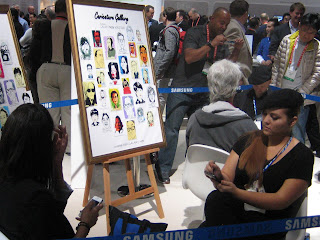Dressed in a beautiful gown, her hair trimmed with gardenias, her face beaming, Hattie McDaniel arrived at the Cocoanut Grove in Los Angeles' Ambassador Hotel on February 29, 1940 for the Twelfth Academy Awards. That night she would make history by becoming the first black actress to receive an Oscar for a supporting role in the film "Gone with the Wind". Ironically, she and her guest sat at a table for two, separated from the other guests due to their skin colour. Nonetheless, Miss McDaniel was thrilled to be given the role and the award stating that she "would rather play a maid than be a maid".
Born in Kansas in 1895 to a Civil War veteran father and a gospel singer mother, Hattie and her family moved to Colorado when she was young. She attended elementary and high school there, but then left school to hone her skills as a singer, songwriter, actress and comedienne. Hattie was the first black woman to sing on American Radio. She and her brother participated in a minstrel show in the 1920's. Hattie then moved to Hollywood where she found work on The Optimistic Do-Nut Hour on radio.
Her film debut in "The Golden West" took place in 1932. Starring in almost 40 films in the 1930's, Hattie almost always played a maid or a cook. The N.A.A.C.P. criticized her for perpetuating black stereotypes even down to the "Negro dialect" that she used when she delivered her lines. However, to her credit, Hattie usually turned these maids into "sassy, independent" characters.
In 1939, the role of the lifetime presented itself to her when she auditioned for Margaret Mitchell's "Gone with the Wind". Although the competition was almost as stiff for the "Mammy" (a former slave turned maid) role as for the "Scarlet O'Hara" (Southern debutante) role, Hattie still aced the audition, arriving in a proper maid's uniform and delivering flawless lines. Everyone remembers the famous scene, now depicted on collective plates, of Mammy tightening Scarlet's girdle as the latter holds on to the bedpost. Gone with the wind is the highest grossing movie of all time and won Oscars for best picture, director, screenplay, cinematography, art direction, film editing and best actress, among others.
Hattie went on to make many other movies, but it was impossible to top "Gone with the Wind". She remained friends with Clark Gable, who had played "Rhett Butler", and he attended parties at her house every year. Although she was married four times, each union was shortlived and childless. She passed away of breast cancer in 1952.
Note: I found an excellent poem on the Internet by poet Rita Dove.
HATTIE MCDANIEL ARRIVES AT THE COCONUT GROVE*
late, in aqua and ermine, gardenias
scaling her left sleeve in a spasm of scent,
her gloves white, her smile chastened, purse giddy
with stars and rhinestones clipped to her brilliantined hair,
on her free arm that fine Negro,
Mr. Wonderful Smith.
It's the day that isn't, February 29th,
at the end of the shortest month of the year—
and the [dullest] too, everywhere
except Hollywood, California
where the maid can wear mink and still be a maid,
bobbing her bandaged head and cursing
the white folks under her breath as she smiles
and shoos their silly daughters
in from the night dew…what can she be
thinking of, striding into the ballroom
where no black face has ever showed itself
except above a serving tray?
Hi-Hat Hattie, Mama Mac, Her Haughtiness,
The "little lady" from Showboat whose name
Bing forgot, Beulah & Bertha & Malena
& Carrie & Violet & Cynthia & Fidelia,
one half of the dark Barrymores—
dear Mammy, we can't help but hug you crawl into
your generous lap tease you
with such arch innuendo so we can feel that
much more wicked and youthful
and sleek but oh what
we forgot: the four husbands, the phantom
pregnancy, your famous parties, your celebrated
ice box cake. Your giggle above the red petticoat's rustle,
black girl and white girl walking hand in hand
down the railroad tracks
in Kansas city, six years old.
The man who advised you, now
that you were famous to 'begin eliminating"
your more common acquaintances
and your reply (catching him square
in the eye): "That's a good idea.
I'll start right now by eliminating you."
Is she or isn't she? Three million dishes,
a truckload of aprons and headrags later, and here
you are: poised, between husbands
and factions, no corset wide enough
to hold you in, your huge face a dark moon split
by that spontaneous smile – your trademark,
your curse. Not matter, Hattie: It's a long, beautiful walk
into that flower-smothered standing ovation,
so go on
and make them wait.
Rita Dove
*First published in the New Yorker magazine on May 10, 2004.
Photo of Vivien Leigh and Hattie McDaniel in "Gone with the Wind" courtesy http://classicmoviestills.com.
Wednesday, February 29, 2012
Tuesday, February 28, 2012
If Saddlebags Could Talk
"[The circuit rider] went through storms of wind, hail, snow, and rain; climbed hills and mountains, traversed valleys, plunged through swamps, swollen streams, lay out all night, wet, weary, and hungry, held his horse by the bridle all night, or tied him to a limb, slept with his saddle blanket for a bed, his saddle-bags for a pillow. Often he slept in dirty cabins, ate roasting ears for bread, drank butter-milk for coffee; took deer or bear meat, or wild turkey, for breakfast, dinner, and supper. This was old-fashioned Methodist preacher fare and fortune."*
John Wesley, the first circuit rider and the father of Methodism, was born in 1703 in England. The son of a rector, he grew up in the Anglican church. Attending Oxford University, John, his brother Charles and their friend George Whitefield, started the Holy Club, a Christian group. John and George started preaching in Anglican churches, but were not well received given their message: live your life according to the method laid down in the Bible. They believed that the Holy Spirit converts souls to Christianity and that we should strive for Christian "perfection", keeping our hearts pure. George was a dynamic preacher and when London's Anglican churches banned him, he held an open air service in the small town of Kingswood. John followed suit and attracted an audience of 3000 on his second attempt.
These open air services, or "field preaching" led to circuit riding. John Wesley took his horse, loaded his saddlebags and set out for his charges. Sometimes he faced angry mobs who tried to break up his meetings; sometimes he was stoned or beaten. Yet the Holy Spirit filled him with a fire to spread God's word: he was unstoppable. He travelled England's countryside for forty years, covering a quarter of a million miles, preaching 42,000 sermons, giving away 30,000 pounds. He also wrote 200 books and hundreds of hymns.
On this day in 1784, John Wesley chartered the first Methodist church in the United States. He had felt that after the American Revolution a decade before, English Anglicans had abandonned their American counterparts. With his own brand of Christianity, he tried to fill that spiritual void. He ordained Dr. Thomas Coke who went on to ordain Francis Asbury.
The latter continued Wesley's tradition of circuit riding in America. Circuit riders with small territories had three or four churches to visit, but riders with big circuits had to cover 300 miles. They were poorly paid, persecuted, and had little time to rest; in fact, some had to read the Bible while on horseback to prepare their sermons. Marriage was frowned upon for circuit riders and life on the road was lonely. Half of them died before the age of 33 due to the harsh conditions and unrealistic expectations.
Yet despite their struggles, circuit riders sparked a hunger for Christianity in America. By 1800, tent revivals sprung up in the Appalachians, the first meeting being held in Kentucky and attracting 10,000 people. These tent revivals led to more congregations forming which led to more churches being built. The circuit riders gave a great contribution to Methodism and to Christianity in North America (Canada also had circuit riders). And it all started with a young man named John Wesley.
*Source: "Circuit Riders in Early American Methodism", Robert Simpson.
Drawing of John Wesley on horseback courtesy http://4.bp.blogspot.com.
John Wesley, the first circuit rider and the father of Methodism, was born in 1703 in England. The son of a rector, he grew up in the Anglican church. Attending Oxford University, John, his brother Charles and their friend George Whitefield, started the Holy Club, a Christian group. John and George started preaching in Anglican churches, but were not well received given their message: live your life according to the method laid down in the Bible. They believed that the Holy Spirit converts souls to Christianity and that we should strive for Christian "perfection", keeping our hearts pure. George was a dynamic preacher and when London's Anglican churches banned him, he held an open air service in the small town of Kingswood. John followed suit and attracted an audience of 3000 on his second attempt.
These open air services, or "field preaching" led to circuit riding. John Wesley took his horse, loaded his saddlebags and set out for his charges. Sometimes he faced angry mobs who tried to break up his meetings; sometimes he was stoned or beaten. Yet the Holy Spirit filled him with a fire to spread God's word: he was unstoppable. He travelled England's countryside for forty years, covering a quarter of a million miles, preaching 42,000 sermons, giving away 30,000 pounds. He also wrote 200 books and hundreds of hymns.
On this day in 1784, John Wesley chartered the first Methodist church in the United States. He had felt that after the American Revolution a decade before, English Anglicans had abandonned their American counterparts. With his own brand of Christianity, he tried to fill that spiritual void. He ordained Dr. Thomas Coke who went on to ordain Francis Asbury.
The latter continued Wesley's tradition of circuit riding in America. Circuit riders with small territories had three or four churches to visit, but riders with big circuits had to cover 300 miles. They were poorly paid, persecuted, and had little time to rest; in fact, some had to read the Bible while on horseback to prepare their sermons. Marriage was frowned upon for circuit riders and life on the road was lonely. Half of them died before the age of 33 due to the harsh conditions and unrealistic expectations.
Yet despite their struggles, circuit riders sparked a hunger for Christianity in America. By 1800, tent revivals sprung up in the Appalachians, the first meeting being held in Kentucky and attracting 10,000 people. These tent revivals led to more congregations forming which led to more churches being built. The circuit riders gave a great contribution to Methodism and to Christianity in North America (Canada also had circuit riders). And it all started with a young man named John Wesley.
*Source: "Circuit Riders in Early American Methodism", Robert Simpson.
Drawing of John Wesley on horseback courtesy http://4.bp.blogspot.com.
6 over
can't wait to see this movie!
check this teaser at about 1.22m what a nice taillight!
check this teaser at about 1.22m what a nice taillight!
6 Over - Teaser from Wild Honey Productions on Vimeo.
Monday, February 27, 2012
Ontario's Train Stations
I remember visiting the Hamilton Train Station in the North end to pick up my grandparents on Christmas Eve. It was a huge stone building with four columns like the Parthenon; inside were high ceilings and long wooden benches. Built in a modern style, the station closed in recent years and now houses Liuna Gardens, a restaurant for wedding receptions.
Hamilton Railway Station photo courtesy www.thespec.com.
Hamilton Railway Station photo courtesy www.thespec.com.
When we moved to Brantford, we invited a friend from Windsor who arrived on the train. I was pleased to see that the city had preserved the original brown brick station complete with a large turret designed in the Gothic, Romanesque and Chateauesque styles.
My Dad used to take the train to visit his uncle in Kirkton. He and his Dad would stop at St. Mary's junction, a one storey stone building with gabled roofs, arched windows and doors. Then they would head to a restaurant in the stone town, a rare occasion, where they would dine on liver and onions.
Photo of St. Mary's Junction courtesy http://viastation1.jpg.
My Dad and my Grandad would start their journey at Toronto's Union Station, a majestic building with a row of columns at the front, constructed in the beaux arts classicism style.
Photo of Toronto's Union Station courtesy http://planetware.com.
When I visited Goderich in the summers as a child, I got to take a peek at its train station, a red brick building with a large turret.
Photo courtesy http://farm1.staticflickr.com.
We drove by the Kingston train station when we went to the Thousand Islands in 1997; it is a beautiful two storey building with a mansard roof.
Photo of Kingston Train Station courtesy http://farm1.staticflickr.com.
When we visited Westfield Heritage Village near Rockton, we took a peek at the Jerseyville train station, a quaint wooden structure that was used to film the 1980's TV production of "Anne of Green Gables".
Train stations are often beautiful structures and I am pleased to see that many of the Ontario buildings have been preserved.
Sunday, February 26, 2012
I Walk the Line
According to Wikipedia, Johnny Cash was a "troubled, but devout Christian". Although his song "I Walk the Line" refers to his attempts to stay faithful to his first wife, Vivian Liberto, while he was on the road, you could say that he "walked the line" between darkness and light. Raised in a Christian home, Cash was always a believer, but he battled addictions to drugs and alcohol that would haunt him for much of his life. But what I believe appealed to the general public was how real Johnny Cash was. He showed a rare and refreshing humility.
Johnny Cash was born on this day in 1932 in Arkansas, the fourth child of seven. His father was a cotton farmer and his mother, a homemaker. Growing up during the Great Depression, the family struggled financially especially when their farm was flooded not once but twice leading Johnny to write "Five Feet High and Rising". Close to his older brother Jack, Johnny was devastated when his brother was almost cut in two by a saw while working at the local mill. Within a week, Jack passed away and Johnny always felt guilty that he had not been present to help him, but was off fishing that day instead. One outlet for Johnny was music: he played guitar and wrote songs at an early age.
By 1950, he joined the Army and was assigned to an American base in Germany. He had met a girl named Vivian Liberto three weeks before he deployed and during his time abroad, the couple exchanged many love letters. Returning to the United States in 1954, Johnny and Vivian married. Within a short time, they started a family: Rosanne, Kathy, Cindy and Tara. Johnny took a job selling appliances while he studied radio announcing.
He got up the courage to audition at Sun Records, but his gospel sound was originally turned down. He returned to play a rockabilly song and this time was given a contract. In 1956, Johnny got to jam in an impromptu session with Elvis Presley, Jerry Lee Lewis and Carl Perkins.
By the early 1960's, Johnny started touring with the Carter Family, including June, and her two sisters. Johnny had given into temptation and had carried on affairs by this point in his marriage. He found himself strongly attracted to June. His years on the road had taken their toll, evident in songs like "So Doggone Lonesome".
He turned to alcohol to relieve the loneliness, evident in one song he wrote called "Kneeling Drunkard's Plea". Because of the pressures of performing and having to stay awake for long hours, Johnny also found himself addicted to barbituates. Due to drug possession, he did spend the night in jail on a couple of occasions, although not in Folsom Prison. The song "Folsom Prison Blues", one of his signature songs, was based on the movie "Inside the Walls of Folsom Prison", which he watched while he was in the Army in 1951. Johnny felt compassion for prisoners and later held free concerts in American prisons.
The singer found refuge in his faith in God, evident in the fact that he liked to sing many Christian songs, some written by him, some by others, like: "Agony in Gethsemane", "Choosing of the Twelve Disciples" and "Crucifixion".
Johnny and Vivian divorced in 1966 and Johnny started dating June Carter. June, with the help of her parents, helped Johnny become sober, staying with him at his mansion for a month straight. In London, Ontario, in 1968, Johnny Cash proposed to June Carter and she said "Yes". They were married later that year in Kentucky and two years later June gave birth to a boy, John Carter Cash.
Johnny went on to record more songs, including many Christian ones. He recorded the new King James version of the New Testament. Always referred to as the "Man in Black", Johnny wrote a song called "Man in White" about Jesus. He also performed and recorded with his wife; they co-wrote the song "Ring of Fire".
Johnny and June's marriage would be a lasting one. June passed away first followed by Johnny in 2003. A memorial headstone for the couple has the inscription: "I Walk the Line".
Photo of Johnny Cash and June Carter Cash courtesy http://upload.wikimedia.org/.

Johnny Cash was born on this day in 1932 in Arkansas, the fourth child of seven. His father was a cotton farmer and his mother, a homemaker. Growing up during the Great Depression, the family struggled financially especially when their farm was flooded not once but twice leading Johnny to write "Five Feet High and Rising". Close to his older brother Jack, Johnny was devastated when his brother was almost cut in two by a saw while working at the local mill. Within a week, Jack passed away and Johnny always felt guilty that he had not been present to help him, but was off fishing that day instead. One outlet for Johnny was music: he played guitar and wrote songs at an early age.
By 1950, he joined the Army and was assigned to an American base in Germany. He had met a girl named Vivian Liberto three weeks before he deployed and during his time abroad, the couple exchanged many love letters. Returning to the United States in 1954, Johnny and Vivian married. Within a short time, they started a family: Rosanne, Kathy, Cindy and Tara. Johnny took a job selling appliances while he studied radio announcing.
He got up the courage to audition at Sun Records, but his gospel sound was originally turned down. He returned to play a rockabilly song and this time was given a contract. In 1956, Johnny got to jam in an impromptu session with Elvis Presley, Jerry Lee Lewis and Carl Perkins.
By the early 1960's, Johnny started touring with the Carter Family, including June, and her two sisters. Johnny had given into temptation and had carried on affairs by this point in his marriage. He found himself strongly attracted to June. His years on the road had taken their toll, evident in songs like "So Doggone Lonesome".
He turned to alcohol to relieve the loneliness, evident in one song he wrote called "Kneeling Drunkard's Plea". Because of the pressures of performing and having to stay awake for long hours, Johnny also found himself addicted to barbituates. Due to drug possession, he did spend the night in jail on a couple of occasions, although not in Folsom Prison. The song "Folsom Prison Blues", one of his signature songs, was based on the movie "Inside the Walls of Folsom Prison", which he watched while he was in the Army in 1951. Johnny felt compassion for prisoners and later held free concerts in American prisons.
The singer found refuge in his faith in God, evident in the fact that he liked to sing many Christian songs, some written by him, some by others, like: "Agony in Gethsemane", "Choosing of the Twelve Disciples" and "Crucifixion".
Johnny and Vivian divorced in 1966 and Johnny started dating June Carter. June, with the help of her parents, helped Johnny become sober, staying with him at his mansion for a month straight. In London, Ontario, in 1968, Johnny Cash proposed to June Carter and she said "Yes". They were married later that year in Kentucky and two years later June gave birth to a boy, John Carter Cash.
Johnny went on to record more songs, including many Christian ones. He recorded the new King James version of the New Testament. Always referred to as the "Man in Black", Johnny wrote a song called "Man in White" about Jesus. He also performed and recorded with his wife; they co-wrote the song "Ring of Fire".
Johnny and June's marriage would be a lasting one. June passed away first followed by Johnny in 2003. A memorial headstone for the couple has the inscription: "I Walk the Line".
Photo of Johnny Cash and June Carter Cash courtesy http://upload.wikimedia.org/.
Saturday, February 25, 2012
Exercise Gives You Energy
I joined a fitness club two years ago and I have never regretted the decision. Ironically, exercise gives me more, not less energy. I used to exercise first thing in the morning and it would give me the energy to make the long drive to Brampton to visit my sister when she was in the hospital. Exercise not only gives you physical energy but mental energy as well. If I have cobwebs in my brain, a turn on the elliptical machine can clean them right out. I find that I often get good ideas when I am exercising. The circulation of the blood leads to the awakening of the mind. When I get off the elliptical machine, I often have my most lucid moments. No matter how badly I feel when I arrive at the gym, I always feel better once I leave. If I push myself hard enough, I get a natural high. And the older you get, the more you need exercise. Your metabolism slows down, your bones lose density, your muscles shrink, your stress increases. Working out can control all of these things. Thank you, McFit!
Friday, February 24, 2012
Frozen Falls
On February 24, 1888, a local newspaper reported that 20,000 people had tobogganed on a natural ice bridge at Niagara Falls that day. In fact, people littered the Niagara Gorge's frozen banks like ants on an anthill. Tourists visited shanties on the ice where they purchased liquor, photographs or curiosities. One winter, back in 1848, Niagara Falls residents woke up to silence, wondering what had happened to the roar of the falls: the chute had frozen in mid-air, due to an ice jam on the river, turning it into a giant wall of icicles. The chute would freeze in later winters as well including: 1902, 1909, 1911, 1936 , 1938 and 1949. The ice bridge continued to be a source of entertainment for Niagara Falls tourists until 1912 when the ice bridge collapsed and some people fell into the river, resulting in three drowning deaths. From that year on, crossing the ice bridge became illegal. Not every year saw the formation of the ice bridge, but it was so thick in 1938 that it caused the collapse of the Honeymoon Bridge. Some years authorities used dynamite to break up that ice bridge when it became too thick. The last ice bridge formed in 1954. Ten years later, authorities started putting an ice boom across the river at Lake Erie to prevent the formation of an ice bridge on the Niagara Gorge.
Photo of frozen Niagara Gorge circa 1902 courtesy http://1.bp.blogspot.com.
Photo of frozen gorge and chute called "Cave of the Winds in Winter, Niagara Falls" circa 1909 courtesy www.niagarafrontier.com.
Thursday, February 23, 2012
Picture a Tree
Barbara Reid visited Brantford Christian School today as part of their Book Fair. As a volunteer at the book table, I got to listen in on her presentation to the students. And what a presentation it was! Barbara started by giving the kids some back ground on her various books including Two by Two (about Noah's Ark), The Subway Mouse (she lives on the Danforth in Toronto, just above the subway), The Party (about her two little girls going to a birthday party), The Gift (about a lady travelling the globe looking for the perfect present), Have You Seen Birds?, Fox Walked Alone, Read Me a Book, Sing a Song of Mother Goose and Perfect Snow (her girls building a snow fort at school).
She told us that designing a picture for a book using plasticine was like making a pizza. As a chef begins with a crust, she begins with a piece of cardboard. Then bit by bit she adds different colours of plasticine just as a chef adds the toppings. She explained how she used certain instruments to show texture in her pictures like the end of a paintbrush to poke holes in the moon or the tip of a pencil to make a hole in a cow's ear.
Barbara spent a lot of time discussing her inspiration for her newest book, Picture a Tree. For instance, she has a dog named Ruby that she walks each day and she notices the trees as she strolls. Here are some of her observations. For instance, an early picture contrasts a black tree against a winter-white sky. Another picture shows how a cloud behind a tree can make it look like it has hair. The author features a tree-lined street that looks like an archway, using brilliant colours to form the old Toronto houses. A busy high rise apartment building serves as the backdrop for a large tree which provides a bird's eye view of the goings-on of the tenants (the tree has a busy beehive to mimic the lady in the window who is multitasking). "Some trees are sun umbrellas" says the caption above a busy street scene on the Danforth showing kids eating ice cream on a sweltering summer day. Barbara shows the different generations as she contrasts an old twisted tree with a grandfather examining it and a baby tree that is just starting to sprout beside an infant in his bouncy chair Fall foliage in full bloom is what the author calls "a wild goodbye party". Snowcovered trees mimick children in snowsuits. White blossoms signal spring. The final scene shows her dog, Ruby, to whom the book is dedicated.
I rushed to Lynden Park Mall and bought the last copy of Picture a Tree in town and then had it autographed by the author. The next time you visit a bookstore or library, pick up a Barbara Reid book. They are amazing!
She told us that designing a picture for a book using plasticine was like making a pizza. As a chef begins with a crust, she begins with a piece of cardboard. Then bit by bit she adds different colours of plasticine just as a chef adds the toppings. She explained how she used certain instruments to show texture in her pictures like the end of a paintbrush to poke holes in the moon or the tip of a pencil to make a hole in a cow's ear.
Photo courtesy www.mommykatandkids.com.
Barbara spent a lot of time discussing her inspiration for her newest book, Picture a Tree. For instance, she has a dog named Ruby that she walks each day and she notices the trees as she strolls. Here are some of her observations. For instance, an early picture contrasts a black tree against a winter-white sky. Another picture shows how a cloud behind a tree can make it look like it has hair. The author features a tree-lined street that looks like an archway, using brilliant colours to form the old Toronto houses. A busy high rise apartment building serves as the backdrop for a large tree which provides a bird's eye view of the goings-on of the tenants (the tree has a busy beehive to mimic the lady in the window who is multitasking). "Some trees are sun umbrellas" says the caption above a busy street scene on the Danforth showing kids eating ice cream on a sweltering summer day. Barbara shows the different generations as she contrasts an old twisted tree with a grandfather examining it and a baby tree that is just starting to sprout beside an infant in his bouncy chair Fall foliage in full bloom is what the author calls "a wild goodbye party". Snowcovered trees mimick children in snowsuits. White blossoms signal spring. The final scene shows her dog, Ruby, to whom the book is dedicated.
Photo courtesy www.2.bp.blogspot.com.
I rushed to Lynden Park Mall and bought the last copy of Picture a Tree in town and then had it autographed by the author. The next time you visit a bookstore or library, pick up a Barbara Reid book. They are amazing!
Wednesday, February 22, 2012
Just As I Am
It is estimated that he brought more than 3.2 million people to Christ. He was the spiritual advisor to every American President from Truman to Bush. He has visited at least 185 countries in his lifetime. He has written 29 books and is approaching his 95th birthday. His name is Billy Graham.
Although he is known worldwide today, Billy Graham had humble roots. He was born on November 7, 1918, the son of a North Carolina dairy farmer. He converted to Christianity at a revival meeting back in 1934. He attended Florida Bible Institute where he would paddle a canoe up the Hillsborough River, p[reaching to the birds, alligators and cypress stumps. Graduating in 1940, he then attended Wheaton college in Illinois, obtaining an anthropology degree three years later.
In 1943, Billy married Ruth Bell and they resided in a log cabin in North Carolina designed by his bride. He was ordained by the Southern Baptist Convention and started preaching. However, Billy Graham did not achieve national recognition until 1949 when he conducted revival meetings in tents in Los Angeles. Billy delivered sermons on the radio and on TV. The evangelical caught the eye of William Randolph Hearst, a news mogul who promoted the pastor in his newspapers. By 1954, Billy Graham graced the cover of Time magazine.
While busy at work, he also made time for family as he and his wife had five children. With fame, came certain dangers. In his everyday routine, Billy always made it a point of never being alone with a woman other than his wife, even leaving an elevator that carried just one woman, so as not to be accused of inappropriate behaviour. This came to be known as the Billy Graham Rule.
By the 1950's, Billy started holding crusades in parks, theatres and other large venues. In 1964, he filled a pavilion at the World's Fair in New York City. Preaching the gospel, he would surround himself with a choir of up to 5000 members. As the choir sang "Just As I Am", the pastor would hold an altar call, asking people to come to the front and give their lives to Christ. Billy Graham was the first big name evangelist to go behind the Iron Curtain, risking the wrath of the Communist leaders. At one such crusade in Moscow in 1992, a quarter of the audience (155,000 people) responded to his altar call.
Yes, Billy Graham has brought millions of people to Christ through word of mouth, through the media, through the 29 books he has written, and through his crusades. Everyone knows his name. However, who brought Billy Graham to Christ? A farm worker named Albert McMakin. One person can make a big difference.
Note: Billy Graham has left a legacy for his 5 children, 19 grandchildren and 28 great-grandchildren. His son Franklin, also a minister, runs Samaritan's Purse which oversees Operation Christmas Child, among other things. His grandson, Tullian Tchividjian, is the senior pastor at Coral Ridge Presbyterian Church in Florida.
Photo courtesy http://upload.wikimedia.org.
Although he is known worldwide today, Billy Graham had humble roots. He was born on November 7, 1918, the son of a North Carolina dairy farmer. He converted to Christianity at a revival meeting back in 1934. He attended Florida Bible Institute where he would paddle a canoe up the Hillsborough River, p[reaching to the birds, alligators and cypress stumps. Graduating in 1940, he then attended Wheaton college in Illinois, obtaining an anthropology degree three years later.
In 1943, Billy married Ruth Bell and they resided in a log cabin in North Carolina designed by his bride. He was ordained by the Southern Baptist Convention and started preaching. However, Billy Graham did not achieve national recognition until 1949 when he conducted revival meetings in tents in Los Angeles. Billy delivered sermons on the radio and on TV. The evangelical caught the eye of William Randolph Hearst, a news mogul who promoted the pastor in his newspapers. By 1954, Billy Graham graced the cover of Time magazine.
While busy at work, he also made time for family as he and his wife had five children. With fame, came certain dangers. In his everyday routine, Billy always made it a point of never being alone with a woman other than his wife, even leaving an elevator that carried just one woman, so as not to be accused of inappropriate behaviour. This came to be known as the Billy Graham Rule.
By the 1950's, Billy started holding crusades in parks, theatres and other large venues. In 1964, he filled a pavilion at the World's Fair in New York City. Preaching the gospel, he would surround himself with a choir of up to 5000 members. As the choir sang "Just As I Am", the pastor would hold an altar call, asking people to come to the front and give their lives to Christ. Billy Graham was the first big name evangelist to go behind the Iron Curtain, risking the wrath of the Communist leaders. At one such crusade in Moscow in 1992, a quarter of the audience (155,000 people) responded to his altar call.
Yes, Billy Graham has brought millions of people to Christ through word of mouth, through the media, through the 29 books he has written, and through his crusades. Everyone knows his name. However, who brought Billy Graham to Christ? A farm worker named Albert McMakin. One person can make a big difference.
Note: Billy Graham has left a legacy for his 5 children, 19 grandchildren and 28 great-grandchildren. His son Franklin, also a minister, runs Samaritan's Purse which oversees Operation Christmas Child, among other things. His grandson, Tullian Tchividjian, is the senior pastor at Coral Ridge Presbyterian Church in Florida.
Photo courtesy http://upload.wikimedia.org.
Tuesday, February 21, 2012
La Gazzella Negra
It was the summer of 1960 in Rome, Italy. At the Stadio Olimpico, the thermometre had reached 110 degrees Fahrenheit as 80,000 spectators waited anxiously for the race to start. Eight women took their mark at the start line for the 100 metre dash. The gun popped and the women took flight. The American pulled ahead and blazed to the finish in 11 seconds flat, a world record if not for the wind at her back. For the second race, the American took her place once again on the track. The spectators watched in anticipation for the 200 metre race. Once again, the American passed everyone, crossing the finish line in 23.2 seconds and breaking the Olympic record. A few days later, the American, Wilma Rudolph, along with her 3 teammates, lined up for the 4 by 100 metre relay. Baton in hand, the women who would run the first leg of the race put their feet into the blocks. The gun went off and the women burst out of the blocks. One by one, the American women blazed down the track, winning the race in 44.5 seconds and setting a world record. Wilma Rudolph, watched the American flag raise and listened to the Star Spangled Banner 3 times in Stadio Olimpico that summer. The Italians nicknamed her "La Gazzella Negra", the black gazzelle.
What makes Wilma Rudolph's story even more remarkable is her childhood. Raised by a railroad porter father and a maid mother, she was the 20th of 22 children. Because the family was poor, the mother often made her daughters' dresses out of flour sacks. Only 4.5 pounds at birth, Wilma seemed to get every disease, including scarlet fever and polio. Being black, her parents could not take her to the white hospital to be treated and her mother often had to care for her on her own. After her bout with polio, doctors told Mrs. Rudolph that Wilma would never walk again. Wilma wore a leg brace from age 6 to 9. Her mother refused to accept this news and took Wilma to a black hospital in Nashville. Wilima wore a leg brace from ages 6 to 9. Then for two years, her mother took her twice a week to the Nashville hospital for physiotherapy. Mrs. Rudolph and her other children also gave Wilma exercices at home to restore her crippled leg. At 12, Wilma started walking on her own, her leg healed. In junior high, she joined her school basketball team, but the coach did not let her play for three years. By high school, she became a starting guard, setting state records and leading them to a state championship. Wilma caught the eye of the Tennessee State track and field coach who offered her a full track scholarship.
After the 1960 Summer Olympics, Wilma flew home from Rome where a parade awaited her in Clarksville. She insisted that it be racially integrated, the first such event ever held in her hometown. She retired from track in 1962, studied at university and then took a job as a teacher at her alma mater.
Wilma Rudolph crossing finish line of women's relay at Stadio Olimpico in Rome in 1960 courtesy http://graphics8.nytimes.com.
What makes Wilma Rudolph's story even more remarkable is her childhood. Raised by a railroad porter father and a maid mother, she was the 20th of 22 children. Because the family was poor, the mother often made her daughters' dresses out of flour sacks. Only 4.5 pounds at birth, Wilma seemed to get every disease, including scarlet fever and polio. Being black, her parents could not take her to the white hospital to be treated and her mother often had to care for her on her own. After her bout with polio, doctors told Mrs. Rudolph that Wilma would never walk again. Wilma wore a leg brace from age 6 to 9. Her mother refused to accept this news and took Wilma to a black hospital in Nashville. Wilima wore a leg brace from ages 6 to 9. Then for two years, her mother took her twice a week to the Nashville hospital for physiotherapy. Mrs. Rudolph and her other children also gave Wilma exercices at home to restore her crippled leg. At 12, Wilma started walking on her own, her leg healed. In junior high, she joined her school basketball team, but the coach did not let her play for three years. By high school, she became a starting guard, setting state records and leading them to a state championship. Wilma caught the eye of the Tennessee State track and field coach who offered her a full track scholarship.
After the 1960 Summer Olympics, Wilma flew home from Rome where a parade awaited her in Clarksville. She insisted that it be racially integrated, the first such event ever held in her hometown. She retired from track in 1962, studied at university and then took a job as a teacher at her alma mater.
Wilma Rudolph crossing finish line of women's relay at Stadio Olimpico in Rome in 1960 courtesy http://graphics8.nytimes.com.
Subscribe to:
Posts (Atom)
















































